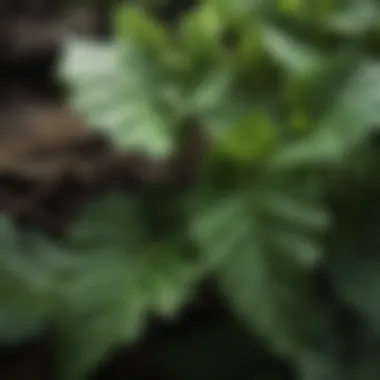Planting Lungwort: Your Complete Guide to Care


Intro
Lungwort, known for its captivating foliage and ecological benefits, is a perennial plant that deserves attention from both gardening enthusiasts and forestry professionals. This plant, capable of enhancing shade gardens, is notable for its role in promoting biodiversity. Understanding how to cultivate and care for lungwort is essential for those looking to improve woodland health and enrich their environmental contributions. This guide will explore various aspects of lungwort, from its ideal planting conditions to ongoing care, ensuring vibrant growth.
Understanding Forestry Practices
In order to fully appreciate lungwort’s significance, one must first understand the fundamental practices of forestry. Effective forestry contributes positively to the ecosystem, ensuring balance and diversity within plant communities.
Types of Forestry Practices
Forestry practices can be broadly categorized. They include:
- Sustainable forestry: This approach balances environmental health with economic gain. It protects biodiversity while providing resources.
- Conservation forestry: Focused on preserving natural habitats, this practice prioritizes the ecological status of the forest. It prevents degradation and promotes native plant growth like lungwort.
- Selective logging: This method involves removing certain trees while leaving others intact. This practice maintains the forest structure and aids in the regeneration of understory plants.
Historical Context
The development of forestry practices has evolved significantly. Historical practices often did not consider the long-term ecological impacts. However, modern practices emphasize balance and conservation, benefitting both the environment and the economy. Understanding this context provides insight into why lungwort is valued, not just for its beauty, but also for its role in sustaining forest health.
Principles of Woodland Stewardship
Lungwort thrives within ecosystems that are carefully managed. The principles of woodland stewardship guide responsible practices that foster health and viability of forests.
Conservation Techniques
Conservation is at the heart of woodland stewardship. Effective techniques include:
- Soil health management: Healthy soil supports plant vitality.
- Species diversity promotion: Diverse plantings reduce susceptibility to pests and diseases. Lungwort contributes to this diversity.
- Water management: Proper water practices sustain both lungwort and surrounding flora.
Managing Forest Resources
Managing resources involves thoughtful practices. It includes evaluating tree stands and ensuring that water, soil, and biodiversity are preserved for future generations. Such practices directly benefit lungwort and similar species by maintaining a thriving ecosystem.
Sustainable Forest Management
To sustain the benefits of forestry, practices must be rooted in sustainability. This section explores key components of sustainable forest management.
Certification Standards
Various certification standards exist to ensure forestry practices are responsible. These include guidance from organizations like the Forest Stewardship Council. By adhering to these standards, forests can be managed sustainably, allowing for the inclusion of beneficial plants like lungwort.
Economic Benefits of Sustainability
Sustainability also presents economic benefits. Responsible resource management can lead to:
- Increased marketability of products
- Improved ecosystem services
- Better quality of life for forest-dependent communities
"Sustainable forest management encourages a healthy balance between economic needs and ecological integrity, benefiting all involved."
By implementing these practices, forestry professionals can foster environments where lungwort and other valuable species can thrive. Understanding the details presented in this guide will empower readers to make informed decisions in their planting and management practices, ensuring future generations can enjoy the ecological benefits of lungwort.
Preamble to Lungwort
Lungwort, a unique perennial flower, offers a myriad of benefits and considerations for those keen in horticulture and forest management. This section outlines essential characteristics of lungwort, its relevance within ecosystems, and its appeal as a decorative plant.
Definition and Characteristics


Lungwort belongs to the Boraginaceae family, primarily within the genus Pulmonaria. These plants are distinguished by their striking foliage and bell-shaped flowers, which typically vary from blue to pink. The leaves often exhibit a spotted or mottled pattern, providing an attractive ground cover. The height of lungwort generally ranges between 12 to 18 inches.
Key characteristics include:
- Shade tolerance: Lungwort thrives in shady environments, making it ideal for woodland gardens.
- Early bloomers: They often blossom in spring when little else is in flower, attracting early pollinators.
- Soil adaptability: These plants are versatile regarding soil types, often flourishing in rich, well-drained soils.
Its compatibility with diverse ecosystems, particularly woodland settings, reinforces lungwort's importance in horticulture.
Historical Significance
Historically, lungwort has been recognized for both its ornamental value and medicinal uses. In the Middle Ages, it was reputed to treat lung diseases. The name "lungwort" itself is derived from its once-assumed ability to remedy respiratory ailments. This connection to traditional herbal medicine underscores the significance of this plant in botanical history and cultural practices.
In addition, many gardeners have cultivated lungwort for its ability to compete with weeds and its attractive display. Its widespread use has contributed to its presence in various garden designs, particularly in regions with suitable climates.
Understanding these historical contexts enhances appreciation for lungwort, stressing its utility beyond mere aesthetics.
Ecological Importance
Understanding the ecological importance of lungwort is crucial for both conservation efforts and biodiversity enhancement. This plant plays a significant role in forest ecosystems and contributes to the overall health of the habitats where it resides. By comprehending lungwort's ecological functions, forestry professionals can make informed decisions that support sustainability and ecological balance.
Role in Forest Ecosystems
Lungwort interacts with various organisms in forest ecosystems, contributing to the complex web of life. This perennial plant often grows in shaded areas, under trees, where it helps to stabilize the soil. The dense foliage of lungwort acts as a natural mulch, preventing soil erosion and maintaining moisture, which is essential for other plants as well.
Moreover, lungwort serves as a adaptive habitat within the forest. Its broad leaves provide shelter for small wildlife, including various insects and amphibians. The plant thrives in moist, shady forest floors, which can enhance the diversity of undergrowth flora. This supports nutrient cycling and fosters a richer biological community.
Support for Pollinator Species
Lungwort is not just beneficial for its immediate surroundings; it also plays a pivotal role in supporting pollinator species. The flowers of lungwort emerge in early spring, providing one of the first sources of nectar after winter. This early blooming period is vital for pollinators like bees and butterflies, which rely on these early blooms to survive before other flowers become available.
By planting lungwort, landowners and gardeners can contribute to the health of pollinator populations. Increased accessibility to nectar-rich flowers promotes pollinator visits, which are essential for the reproduction of many plants. Therefore, integrating lungwort into gardens and landscapes can have a broader ecological impact.
In summary, the ecological importance of lungwort cannot be overstated. Its contributions to forest ecosystems and its support for pollinator species provide essential services that enhance biodiversity and woodland health. Understanding these roles helps forestry professionals and enthusiasts appreciate lungwort as more than a mere ornamental plant; it is an integral part of our natural world.
Ideal Growing Conditions
The success of cultivating lungwort hinges significantly on understanding its ideal growing conditions. This perennial plant thrives best in specific environments that align with its natural preferences. By optimizing these conditions, gardeners can ensure vigorous growth and robust health for lungwort.
Soil Preferences
Lungwort prefers well-drained, rich soils that are high in organic matter. The pH level of the soil should ideally hover around 6.0 to 7.0, which is slightly acidic to neutral. Amending the soil with compost or leaf mold will enhance its texture and nutrient profile, fostering the ideal habitat for lungwort.
When preparing the soil, it's crucial to consider drainage. Lungwort does not tolerate waterlogged conditions. If heavy clay is present, adding sand can improve drainage. Incorporating organic mulch not only retains moisture but also suppresses weeds, making the ecosystem more hospitable for lungwort.
"Healthy soil is the foundation for healthy plants. Investing effort in soil preparation pays off exponentially in plant vitality."
Light and Shade Requirements
Lungwort is remarkably adaptable when it comes to light conditions. It flourishes best in partial to full shade. Direct sunlight can lead to wilting, especially in hotter climates. Shaded areas, especially under taller plants or trees, provide a microclimate that maintains soil moisture and coolness, both favorable for lungwort.
In locations with dappled sunlight, lungwort often thrives as it can tolerate some morning sun while avoiding intense afternoon rays. When selecting a planting location, observe how light shifts throughout the day, as this insight can enhance lungwort's overall growth and flowering capacity.
Climate Considerations
Lungwort generally prefers moderate climates, thriving in USDA Hardiness Zones 3 to 8. It exhibits good tolerance to cold conditions, making it a reliable option in cooler regions. Alternatively, in areas with high temperatures, it is best to ensure adequate moisture to combat heat stress.


Rainfall should also be a consideration; lungwort requires consistent moisture but not saturation. In regions with prolonged drought, supplemental watering may be necessary, especially during the establishment phase. By aligning the planting strategy with local climatic conditions, one can significantly boost lungwort's resilience and aesthetic value in gardens.
Techniques for Planting Lungwort
The way lungwort is planted can greatly affect its growth and vitality. Understanding planting techniques is essential to maximize the plant's potential. Proper methods ensure that lungwort thrives in the preferred habitats, which in turn enhances its ecological contributions. Key components of successful planting include site preparation, selection of seeds or transplants, and the methods used during the planting process itself. Each of these elements requires attention to detail, which ultimately supports the long-term health of the plant.
Preparing the Planting Site
Site preparation is the first step in ensuring successful growth of lungwort. This involves selecting an appropriate location, considering factors such as drainage, proximity to other plants, and exposure to light.
- Soil Testing: Before planting, it is crucial to test the soil. Lungwort prefers slightly acidic to neutral soil with a pH range between 6.0 and 7.0. Testing can inform about nutrient levels and the need for amendments.
- Clearing Debris: Remove any debris, including weeds, stones, or competing plants in the designated area. Weeds can outcompete lungwort for nutrients and moisture, especially during its early growth stages.
- Tilling the Soil: Loosening the soil can promote healthy root development. Tilling to a depth of about 12 inches breaks up compacted soil, allowing roots to expand and access vital nutrients.
- Amending Soil: Based on the soil test results, consider adding organic matter like compost or peat moss. This enhances water retention and provides essential nutrients for lungwort.
Overall, a well-prepared planting site contributes significantly to the growth outcome.
Selecting Seeds or Transplants
Choosing the right seeds or transplants is another critical step for successful lungwort cultivation. Both seeds and transplants have their advantages, and the decision largely depends on the gardener’s preference and resources.
- Seeds: Planting seeds is a cost-effective method. However, it requires patience as germination can take longer. Seeds should be sown in a full sun condition until strong enough for transplanting.
- Transplants: Using established lungwort plants can accelerate growth. Ensure that transplants are healthy and free from pests. When choosing transplants, observe their roots. Healthy roots should be firm and not overly crowded.
No matter the choice, attention to sourcing quality seeds or transplants makes a difference in the success of lungwort planting.
Planting Methods
A few different methods can be employed to plant lungwort effectively. Each method has its benefits and is suitable for different scenarios.
- Direct Seeding: This method is straightforward and involves sowing seeds directly into the prepared soil. Plant seeds about 1/4 inch deep. The area should be kept moist until the seeds germinate.
- Transplanting: For those using seedlings or young plants, transplanting is often preferred. Dig holes slightly larger than the root balls and place the plants in the ground, filling in with soil. This minimizes transplant shock.
- Container Planting: Lungwort can also be grown in pots, which is ideal for small spaces or if one wants to control the environment. Ensure containers have sufficient drainage holes.
Ongoing Care and Maintenance
Ongoing care and maintenance are critical components for successful lungwort cultivation. These practices ensure healthy plant growth and contribute to the long-term benefits of lungwort in garden ecosystems. Proper attention to watering, fertilization, and weed control can enhance plant resilience and promote thriving growth.
Watering Practices
Watering lungwort appropriately is vital for its development. This perennial plant prefers moist, well-draining soil but also can tolerate brief dry spells. During its early establishment phase, frequent watering is essential. As a rule of thumb, aim to provide approximately one inch of water per week.
- Deep Watering: Water deeply at the base rather than frequently at the surface. This encourages root systems to extend further into the soil.
- Monitoring Soil Moisture: Regular checks on the soil moisture levels can help determine when to water. The top inch of soil should feel moist but not soaked.
- Adjusting for Climate: During hotter months, lungwort may require more frequent watering. Conversely, in humid climates, reduce frequency to prevent root rot.
Consistent watering patterns can prevent stress on lungwort and allow for richer blooms and foliage.
Fertilization Requirements
Fertilization supports the nutritional needs of lungwort, promoting vigorous growth and vibrant foliage. However, lungwort does not require heavy feeding. A balanced, slow-releasing fertilizer works best.
- Timing: Apply fertilizer in the spring as new growth emerges. This timing aligns with the natural growth cycle of the plant.
- Application Rate: Use recommended amounts to avoid overwhelming the plant, which could lead to nutrient burn. Generally, a quarter-strength solution is sufficient.
- Organic Options: Consider organic fertilizers like compost or well-rotted manure. These not only fertilize but improve soil structure and health.
Weed Control Strategies
Weeds can compete with lungwort for essential resources, including nutrients and water. Implementing effective weed control strategies helps maintain the health of your lungwort plants.
- Mulching: Applying a layer of organic mulch around lungwort can suppress weed growth. Mulch also helps retain soil moisture and regulate soil temperature.
- Regular Inspections: Keep an eye on the planting area for weeds and remove them promptly. This practice reduces competition early on.
- Hand Weeding: When possible, remove weeds by hand to minimize disturbance to lungwort’s root system. Be cautious not to disturb the surrounding soil too much.
In summary, a structured approach to ongoing care and maintenance includes diligent watering, thoughtful fertilization, and proactive weed control. By adhering to these strategies, lungwort can thrive, contributing positively to both ornamental gardens and forest ecosystems.
Common Pests and Diseases


Understanding common pests and diseases that affect lungwort is essential for maintaining its health and ensuring its vitality. Pests and diseases can significantly impact the growth and aesthetic appeal of lungwort, which is valued not only for its beauty but also for its ecological contributions. Familiarity with these threats allows gardeners and forestry professionals to implement effective strategies that minimize damage and promote sustainability.
Identifying Pests
Identifying pests early is crucial for effective management. Several insects may target lungwort, causing various degrees of damage.
- Slugs and Snails: These mollusks are particularly notorious for feasting on lungwort leaves, leaving behind irregular holes and silvery trails on the plant surface. They thrive in moist conditions, making them more prevalent in areas with high humidity.
- Aphids: These small, often green or black insects congregate on young shoots and leaves. They can stunt growth and lead to yellowing foliage. Aphids also excrete honeydew, which can encourage sooty mold growth, further weakening the plant.
- Spider Mites: Though they are tiny, spider mites can cause significant harm. They create webbing on the underside of leaves and can lead to leaf discoloration and eventual drop.
To effectively manage these pests, a close inspection of lungwort plants should be regularly conducted. Look for physical signs like chewing damage or webbing. Early detection allows for the adoption of appropriate interventions before infestations worsen.
Disease Management
Lungwort can be susceptible to a range of diseases, some of which can be particularly challenging to manage. It is crucial to recognize these diseases and take swift action to mitigate their effects.
- Powdery Mildew: This fungal disease appears as white powdery spots on leaves. Conditions of high humidity and low air circulation favor its development. Management includes ensuring adequate spacing between plants for better airflow and possibly applying fungicidal treatments.
- Root Rot: Caused by overly saturated soil, root rot can be fatal. To prevent this, ensure soil has good drainage and avoid waterlogging.
- Leaf Spot: This disease manifests as dark spots on the leaves, which can eventually lead to early leaf drop. Maintaining healthy plants through proper cultural practices, like avoiding overhead watering, can help minimize risk.
Proactive monitoring and cultural practices are the bedrock of successful disease management for lungwort.
It is important to maintain a proactive approach in dealing with pests and diseases. Incorporating healthy practices such as choosing disease-resistant varieties and promoting biodiversity can significantly enhance lungwort's resilience in the garden.
Appropriate pest and disease management not only protects lungwort but also contributes to overall ecosystem health and balance.
Environmental Considerations
The sustainability of our ecosystems has become increasingly relevant in modern horticulture and forestry. Understanding the role of plants like lungwort in their environments offers vital insights into maintaining biodiversity and ecological balance. Lungwort, with its adaptable nature, serves not only as an ornamental plant but also as a beneficial component for its surroundings. This section will illuminate the significant factors surrounding
Lungwort and Biodiversity. Biodiversity refers to the variety of life forms in a particular habitat. Lungwort contributes positively to this diversity. Its presence can support various wildlife species, particularly in woodland settings. For instance, lungwort’s foliage and flowers provide essential nectar for various pollinators like bees and butterflies. By incorporating lungwort in gardening and forestry projects, one effectively enhances the local ecosystem.
In addition, lungwort's ability to thrive in shaded areas allows it to be a suitable choice for undergrowth planting. This helps to establish a healthier forest floor by reducing the impact of weeds. The diverse habitats create niches for a range of organisms, ultimately fostering a balanced ecosystem.
- Provides habitat for microorganisms.
- Increases food sources for pollinators.
- Aids in soil health and stability.
"Biodiversity is vital for ecosystem resilience. The more diverse the environment, the more capable it is of adapting to change."
Sustainable Planting Practices. Implementing sustainable practices in lungwort cultivation can maximize ecological benefits and enhance growth vigor. Sustainable practices encompass both environmental and economic benefits. These can significantly impact how we approach gardening and land management. Here is how:
- Native Species Use: Prioritizing the planting of native lungwort varieties can help maintain regional ecological integrity. Native plants are often better adapted to local climates and soil types, hence require less maintenance.
- Natural Fertilizers: Using compost or organic fertilizers reduces chemical runoff, protecting surrounding life forms. This not only nourishes the lungwort but also enriches the soil.
- Mulching: Applying organic mulch around lungwort beds prevents weeds and retains moisture in the soil. This promotes healthier plant growth while supporting small organisms in the soil.
- Water Management: Implement efficient irrigation practices to minimize water use while ensuring lungwort remains hydrated. Drip irrigation can be a great option.
- Create Biodiverse Ecosystems: Consider planting lungwort alongside other plants. This mix not only prevents disease spread but also attracts beneficial insects to the area.
The collective impact of these sustainable practices can promote long-lasting health within gardens and woodlands. By integrating lungwort thoughtfully, one enhances the ecological fabric of their surroundings, fostering vitality in the environment.
End
The conclusion section plays a pivotal role in synthesizing the various aspects covered in this comprehensive guide. A well-structured conclusion provides cohesion to the narrative, offering the reader a chance to reflect on the importance of each element discussed throughout the article. The significance of lungwort, both as an ornamental and ecological asset, is emphasized here.
A highlight of lungwort is its adaptability and ecological contributions. The plant not only adds aesthetic value to gardens and woodland areas but also supports local biodiversity by attracting pollinators. Understanding the dynamics between lungwort cultivation and its environmental impact is essential for forestry professionals and academics looking to promote sustainable practices. This section reinforces the notion that informed cultivation can significantly influence woodland health and biodiversity.
Additionally, grasping the key insights into lungwort’s growth, care requirements, and ecological roles motivates practitioners to implement best practices. The conclusion reaffirms that each step, from planting to ongoing maintenance, directly contributes to the flourishing of lungwort in various landscapes. As the article delves into sustainable practices, it also encourages foresight in considering future implications of cultivating lungwort within the broader ecosystem.
Summary of Key Insights
In summary, the crucial insights from this article celebrate lungwort’s multifaceted contributions:
- Ecological Benefits: Lungwort fosters biodiversity, creating essential habitats for pollinators and other wildlife.
- Cultivation Techniques: Knowledge about soil, light, and maintenance ensures healthy growth.
- Sustainable Practices: Emphasizing care that promotes longevity for lungwort, while minimizing environmental impacts.
By appreciating these insights, forestry professionals can make informed decisions that enhance the natural landscape.
Future of Lungwort Cultivation
The future of lungwort cultivation looks promising, driven by increasing awareness of sustainable practices and biodiversity conservation. As interest in native plants grows, so does lungwort’s visibility in various horticultural projects. Continuous research and education are necessary to evolve cultivation techniques and make them more environmentally friendly.
The integration of technology in gardening, such as soil monitoring and climate adaptability assessments, can spearhead innovation within lungwort cultivation. Additionally, collaborative efforts among botanical institutions can yield valuable data on lungwort’s role in ecosystem health. As such, engaging forestry professionals to share their experiences will further our understanding of lungwort cultivation and its critical ecological functions.
By focusing on sustainable approaches and collaborative efforts, lungwort stands a chance to flourish in both gardens and the wild, ensuring its preservation and prominent role in our ecosystems for generations to come.







